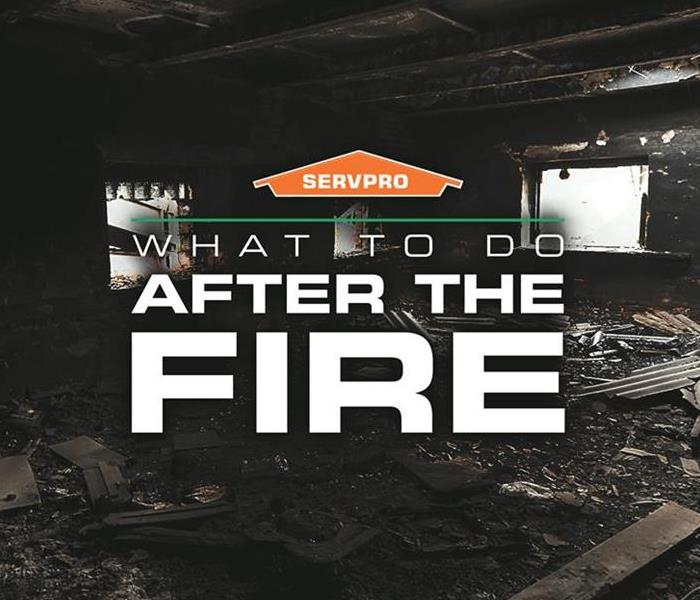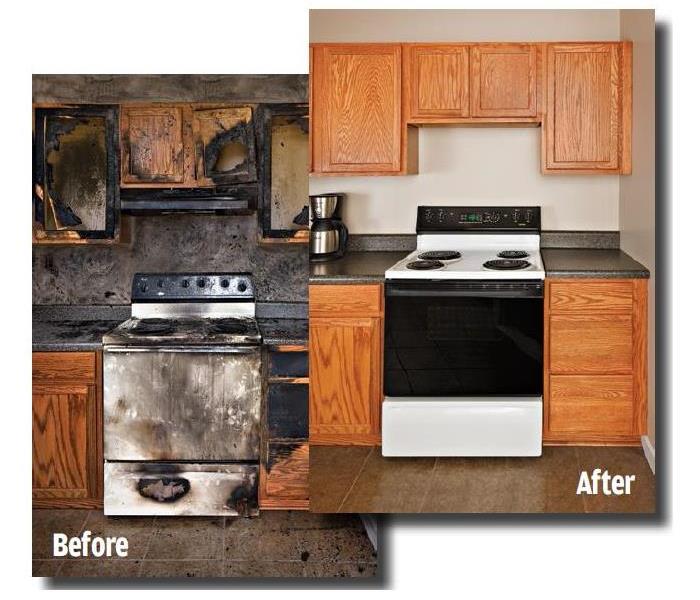Recent Fire Damage Posts
AVOID FIRE HARZARD SIGNS!
11/18/2021 (Permalink)
Electrical wiring
Damage to electrical wiring can cause sparks that quickly lead to damaging fires. Electrical wiring damage may include frayed cords, such as those connecting desktop computers to the wall power outlets. It may also include damage to internal wiring inside the walls, and these may be damaged by pests and other forces. Electrical fires may also start when power sockets are overloaded or when equipment gets too hot.
Flammable Materials
Flammable materials are commonly associated with industrial and warehouse environments, but even restaurants, hotels, dry cleaners and many other types of places may have flammable materials on sight.
There are numerous fire hazards that can cause serious damage to your home or business. If you or anyone you know have been affected by a fire you can call SERVPRO of South Burlington County (856) 988-6195.
FIREMEN WITH FIRE DAMAGE
11/15/2021 (Permalink)
Before SERVPRO comes, the true heroes put out the fire first. However, they often must break windows and cut holes in the roof of buildings on fire. As a fire burns, the fire moves up and down and across, growing very fast. Firefighters break windows and cut holes in roofs to provide ventilation that slows the fire’s growth. Ventilation also helps get rid of dark smoke that makes it hard for firefighters to see where they’re going. The holes and broken windows help firefighters fight the fire more quickly. The bottom line is that breaking windows and cutting holes in roofs help save lives and property. Firefighters will also cut holes in walls at times. That’s not about ventilation. It’s done so the fire department is sure that the fire is completely out. Fire departments don’t want to risk leaving a fire that’s not visible but is still active inside the walls or in other hidden places
SOOT DAMAGE TO BELONGINGS
10/29/2021 (Permalink)
Fire damage, including smoke and soot, effect not only the structure of your house but also your belongings. SERVPRO professionals understand your family’s furniture, clothing, keepsakes, and other belongings are very dear to the heart. SERVPRO professionals specialize in restoring contents damaged by fire. Their expertise can help you save money while preserving precious keepsakes that can’t be replaced. They pretest your belongings to determine what items they can restore to pre-fire condition. They use several methods of cleaning your contents.
- Dry Cleaning - Used for cleaning light residues or to pre-clean prior to wet cleaning.
- Wet Cleaning - An effective cleaning method for removing moderate to heavy residues.
- Spray and Wipe -Effective for items that can’t withstand wet cleaning.
- Foam Cleaning - Used for upholstery fabrics that might shrink or bleed if wet cleaned.
- Abrasive Cleaning - Involves agitation of the surface being cleaned.
- Immersion Cleaning - Contents are dipped into a bath of the cleaning product.
WHAT TO DO IF YOU HAVE A FIRE
10/29/2021 (Permalink)
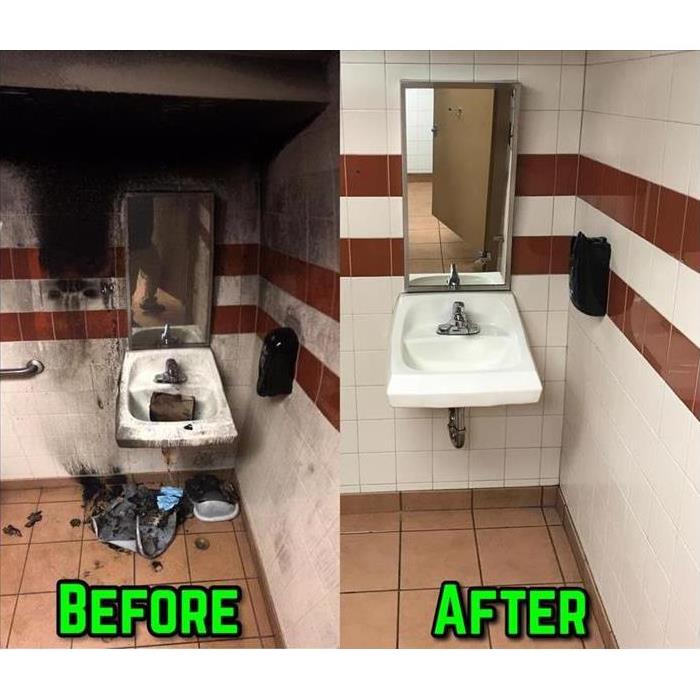 BATHROOM CLEANING WE DID IN A RESTURANT
BATHROOM CLEANING WE DID IN A RESTURANT
Step 1: Emergency Contact
The restoration process begins when you call the SERVPRO National Call Center.
Step 2: Inspection and Fire Damage Assessment
Our Professionals will carefully inspect and test the rooms of your property to determine the extent of the fire, smoke, and soot damage.
Step 3: Immediate Board-Up and Roof-Tarp Service
Fire damage will often compromise windows, walls, and roofs. To maintain security and to protect against further damage, the SERVPRO Franchise Professional can board up missing windows and walls and place tarps on damaged roofs.
Step 4: Water Removal and Drying (if water damage is present)
The water removal process begins almost immediately and removes the majority of the water. They will then use dehumidifiers and air movers to remove the remaining water and complete the drying process.
Step 5: Removal of Smoke and Soot from All Surfaces
The SERVPRO Franchise Professionals use specialized equipment and techniques to remove smoke and soot from ceilings, walls, and other surfaces.
Step 6: Cleaning and Sanitizing
They will clean all of the restorable items and structures that were damaged by the fire. They use a variety of cleaning techniques to restore your belongings to pre-fire condition. They’re also trained to remove odors using industrial air scrubbers and fogging equipment.
Step 7: Restoration
Restoration is the final step—getting your home or business to its pre-fire condition. Restoration may involve minor repairs, such as replacing drywall, painting, and installing new carpet; or it may entail major repairs such as the reconstruction of various areas or rooms in a home or business.
Fire Damage Facts
2/21/2020 (Permalink)
Here are some facts about fire we think you should know.
- In a fire, more people die from inhaling smoke than from the flames. Never think that if you avoid the flames you are safe. Always keep away from smoke.
- Soot is a coating of fine, black dust created when wood, coal, or oil-based substances are burned. These carbon particles float into the air and settle anywhere. Inhaling soot can caused severe lung deficiencies or even death.
- The worst possible effect of soot is its tendency to cause cancer and cause serious defects in newborns. Soot produces polycyclic aromatic hydrocarbons. These hydrocarbons are responsible for gene mutation for particular groups of genes. They can cause birth defects and increase the chances of getting cancer.
If you or anyone else you know has suffered from a fire damage call us today at 856-988-6195
Firemen and Fire Damages
2/21/2020 (Permalink)
Before SERVPRO comes, the true heroes put out the fire first. However, they often must break windows and cut holes in the roof of buildings on fire. As a fire burns, the fire moves up and down and across, growing very fast. Firefighters break windows and cut holes in roofs to provide ventilation that slows the fire’s growth. Ventilation also helps get rid of dark smoke that makes it hard for firefighters to see where they’re going. The holes and broken windows help firefighters fight the fire more quickly. The bottom line is that breaking windows and cutting holes in roofs help save lives and property. Firefighters will also cut holes in walls at times. That’s not about ventilation. It’s done so the fire department is sure that the fire is completely out. Fire departments don’t want to risk leaving a fire that’s not visible but is still active inside the walls or in other hidden places
Don't Let a Space Heater Set a Fire in Your Household.
1/30/2020 (Permalink)
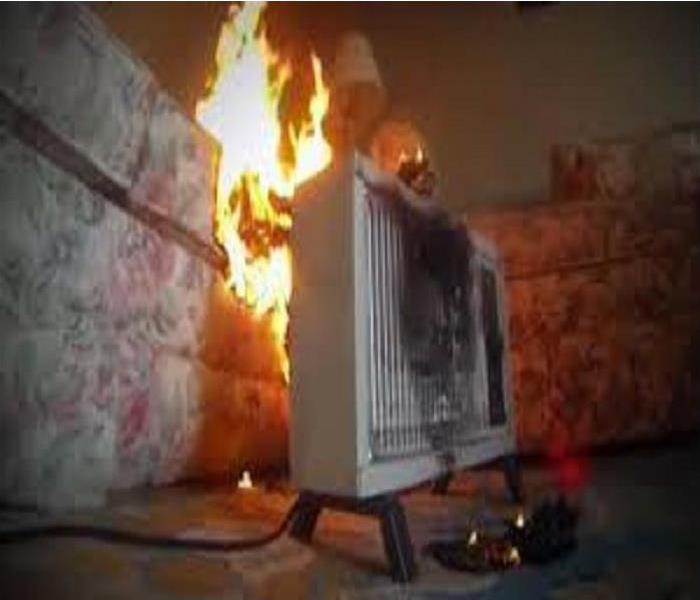 This space heater caught on fire causing the whole room to start burning down in flames.
This space heater caught on fire causing the whole room to start burning down in flames.
Statistically there are about 25,000 residential fires a year in the United States from the use of space heaters in the home. Space heaters should be setup at least a three feet away from any thing that can catch fire such as furniture, boxes, paper or other combustible items. Check your space heater equipment often and clean it regularly. New space heaters have more safety features then old ones. It is a good idea to unplugged the space heater whenever not in use or when you leave your home. Cleaning your space heater can be done by blowing compressed air throughout the inside and vents to get rid of dust and debris that may accumulate and wiping down where you can. Stay safe and stay warm throughout the winter.
What to do after a fire damage
1/30/2020 (Permalink)
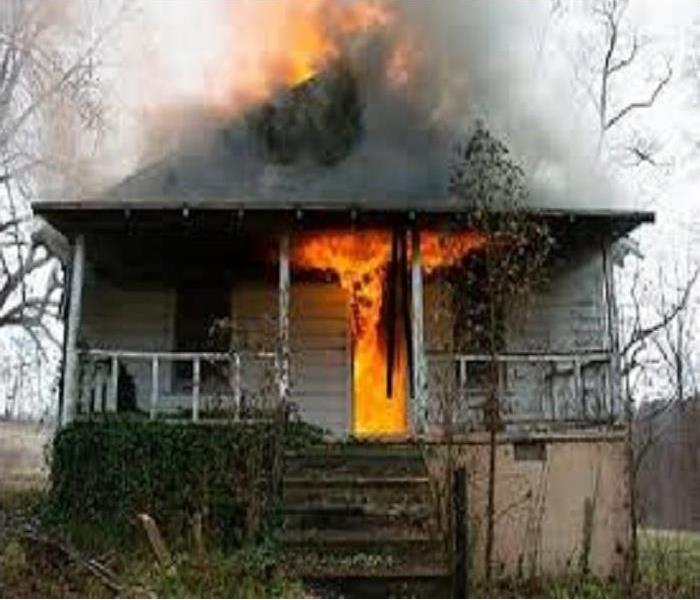 SERVPRO can handle any fire!
SERVPRO can handle any fire!
- Open up your doors and windows: Assuming that the weather permits it, open the doors and windows in your home to help air out your home and remove the smell of smoke.
- Clean what you need to: Any items and fixtures that are made of plastic, chrome, porcelain, and aluminum need to be cleaned immediately after the fire. Otherwise, the tarnishing and etching left behind may become permanent and the item may have to be replaced.
- Use damp cloth over return and supply air registers: This will help catch any loose soot drifting through your home. Even if we clean your home entirely, there may still be a few flecks of soot through the air for a short period of time.
- change the air filter on your furnace: Unfortunately, many furnaces use forced air to circulate through the home. When your filter is full of soot and germs from the fire, you will want to ensure that it won’t be dispersing these contaminants through your home.
What not to do after a fire damage
1/30/2020 (Permalink)
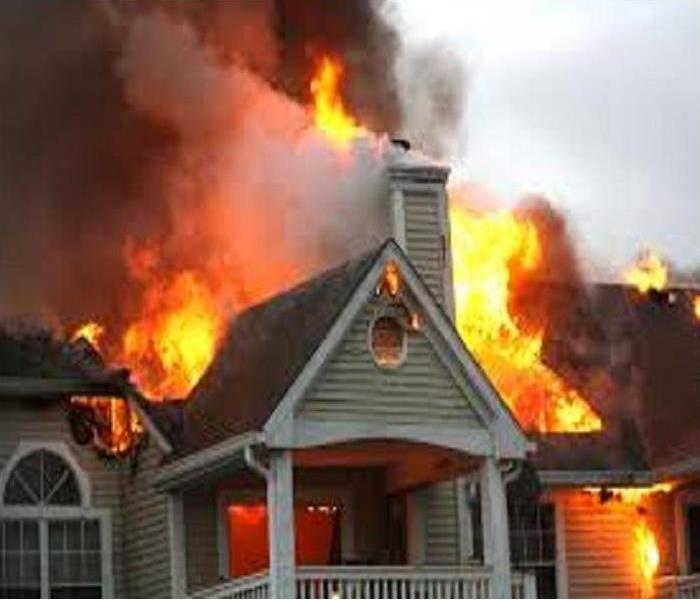 SERVPRO can handle any fire!
SERVPRO can handle any fire!
- Don’t clean by yourself in general: You may be confident in your ability to clean your carpets and your upholstery, but fire damage can leave behind greater issues than your everyday cleaning supplies can handle. Only professional level tools can tackle these.
- Don’t wash the walls by yourself: While soot may look easy to wipe off, it can actually make a bigger mess if you do not have the proper tools and supplies.
- Don’t touch anything with your bare hands: Your hands have oils on them which can often worsen a situation when you touch the walls or certain fabrics.
- Don’t go back into your home until it’s all clear: Make sure that a professional has confirmed that it is safe for you and your family to enter your home again. Walls, floors, and other fixtures may not be stable and could potentially collapse.
Five Tips To Help Prevent Fires This Fall
1/14/2020 (Permalink)
Bonfires. S’more’s. Hot chocolate. Fall decor. Football. Pumpkin spice. And everything nice. All the reasons many people love fall. Sure, fall decor complements your abode, but if you aren’t careful, it can be a safety hazard. A fire can strike your home or business at any given moment, but it doesn’t have to. Prevention is key. In this blog, you will learn about five tips to help prevent fires this fall. However, if it does occur, the fire damage and restoration specialist at SERVPRO® of South Burlington County can be at your residential or commercial property to make the damage “Like it never even happened.”
Five tips to help prevent fires this fall:
- Fall decorations, like dried flowers and cornstalks, are highly flammable. Keep these and other decorations away from open flames and heat sources, including light bulbs and heaters.
- Keep emergency exits clear of decorations so nothing blocks escape routes.
- Teach children to stay away from open flames. Be sure they know how to stop, drop, and roll if their clothing catches fire.
- Remember safety first when choosing a Halloween costume. Consider avoiding billowing fabric. If you are making your costume, choose a material that won’t easily ignite if it comes into contact with heat or a flame.
- It is safest to use a flashlight or battery-operated candle in a Jacko- lantern. Use extreme caution if using a real candle. Place lit pumpkins away from anything that can burn and out of the way of doorsteps, walkways, and yards.
For your safety -- and the safety of members of your family (including pets) -- reference these five tips to help prevent fires this fall. And if you happen to have fire damage at your home or business, the heroes of SERVPRO® of South Burlington County will come to your rescue. We’ll be there with you and your family to guide you throughout the entire process. We’re here when you need us, 24/7, 365 days of the year. Just call 856-988-6195
Do's and Dont's During a Fire Damage
1/2/2019 (Permalink)
What To Do After A Fire
- Limit movement in the home to prevent soot particles from being embedded into upholstery and carpets.
- Keep hands clean so as not to further soil upholstery, walls and woodwork.
- Place clean towels or old linens on rugs, upholstery and carpet traffic areas.
- If electricity is off, empty freezer and refrigerator and prop doors open.
- Clean and protect chrome with light coating of petroleum jelly or oil.
- Wash houseplants on both sides of leaves.
- Change HVAC filter.
- Tape double layers of cheesecloth over air registers.
What NOT To Do After A Fire
- Don't attempt to wash any walls or painted surfaces or shampoo carpet or upholstery without contacting us.
- Don't attempt to clean any electrical appliances that may have been close to fire, heat or water without consulting an authorized repair service.
- Don't use any canned or packaged food or beverages that may have been stored near the fire, heat or water.
- Don't turn on ceiling fixtures if ceiling is wet. The wiring may be damaged.
- Don't send garments to an ordinary dry cleaner. Improper cleaning may set smoke odor.
Fire Cleaning From SERVPRO
1/2/2019 (Permalink)
We offer a range of specialized cleaning methods:
- Bonnet Cleaning: A less aggressive method for short piled carpets.
- Hot Water Extraction: A deeper cleaning method for all carpet types.
- Deluxe Precondition and Rinse: Helps restore deeply soiled areas.
- Showcase Premier Cleaning: The most thorough cleaning method in the industry.
- Dry Cleaning: When color-fastness is an issue.
Our professional cleaning can address moderate and heavy soil conditions in your carpets. How often you’ll need professional cleaning depends on soil build-up, traffic, type and color of carpeting. A good rule of thumb would be to professionally clean your carpet every 12 months. The best advice is to clean carpets before they become totally saturated with soil. If you wait until carpets look really dirty, the carpets may never be restored to their former appearance. Dirt builds up in layers, and when a carpet looks dirty you are only seeing the dirt at the tips of the fibers. More dirt is hiding below the surface down near the base of the pile, causing damage to the carpet. When a carpet is saturated with dirt, the soil has penetrated crevices and has become firmly lodged.
Fire Damage Restoration Process
11/13/2018 (Permalink)
Step 1: Emergency Contact
The restoration process begins when you call the SERVPRO National Call Center.
Step 2: Inspection and Fire Damage Assessment
Our Professionals will carefully inspect and test the rooms of your property to determine the extent of the fire, smoke, and soot damage.
Step 3: Immediate Board-Up and Roof-Tarp Service
Fire damage will often compromise windows, walls, and roofs. To maintain security and to protect against further damage, the SERVPRO Franchise Professional can board up missing windows and walls and place tarps on damaged roofs.
Step 4: Water Removal and Drying (if water damage is present)
The water removal process begins almost immediately and removes the majority of the water. They will then use dehumidifiers and air movers to remove the remaining water and complete the drying process.
Step 5: Removal of Smoke and Soot from All Surfaces
The SERVPRO Franchise Professionals use specialized equipment and techniques to remove smoke and soot from ceilings, walls, and other surfaces.
Step 6: Cleaning and Sanitizing
They will clean all of the restorable items and structures that were damaged by the fire. They use a variety of cleaning techniques to restore your belongings to pre-fire condition. They’re also trained to remove odors using industrial air scrubbers and fogging equipment.
Step 7: Restoration
Restoration is the final step—getting your home or business to its pre-fire condition. Restoration may involve minor repairs, such as replacing drywall, painting, and installing new carpet; or it may entail major repairs such as the reconstruction of various areas or rooms in a home or business.
Fire Damage and Belongings
11/13/2018 (Permalink)
Fire damage, including smoke and soot, effect not only the structure of your house but also your belongings. SERVPRO professionals understand your family’s furniture, clothing, keepsakes, and other belongings are very dear to the heart. SERVPRO professionals specialize in restoring contents damaged by fire. Their expertise can help you save money while preserving precious keepsakes that can’t be replaced. They pretest your belongings to determine what items they can restore to pre-fire condition. They use several methods of cleaning your contents.
- Dry Cleaning - Used for cleaning light residues or to pre-clean prior to wet cleaning.
- Wet Cleaning - An effective cleaning method for removing moderate to heavy residues.
- Spray and Wipe -Effective for items that can’t withstand wet cleaning.
- Foam Cleaning - Used for upholstery fabrics that might shrink or bleed if wet cleaned.
- Abrasive Cleaning - Involves agitation of the surface being cleaned.
- Immersion Cleaning - Contents are dipped into a bath of the cleaning product.
Why Us For The Fire? Do's and Do Not's
11/8/2018 (Permalink)
When your Jersey home or business suffers fire damage, it can be devastating. In addition to the fire and smoke damage, your property may have substantial water damage from firefighting efforts. You may feel stressed and confused after such a disaster, and you’ll need a caring expert to guide you through this crisis. SERVPRO has the specialized fire and water damage equipment and expertise to help you through this time.
What To Do After A Fire
- Limit movement in the home to prevent soot particles from being embedded into upholstery and carpets.
- Keep hands clean so as not to further soil upholstery, walls and woodwork.
- Place clean towels or old linens on rugs, upholstery and carpet traffic areas.
- If electricity is off, empty freezer and refrigerator and prop doors open.
- Clean and protect chrome with light coating of petroleum jelly or oil.
- Wash houseplants on both sides of leaves.
- Change HVAC filter.
- Tape double layers of cheesecloth over air registers.
What NOT To Do After A Fire
- Don't attempt to wash any walls or painted surfaces or shampoo carpet or upholstery without contacting us.
- Don't attempt to clean any electrical appliances that may have been close to fire, heat or water without consulting an authorized repair service.
- Don't use any canned or packaged food or beverages that may have been stored near the fire, heat or water.
- Don't turn on ceiling fixtures if ceiling is wet. The wiring may be damaged.
- Don't send garments to an ordinary dry cleaner. Improper cleaning may set smoke odor.
Fire Hazards That Should Be Avoided
10/29/2018 (Permalink)
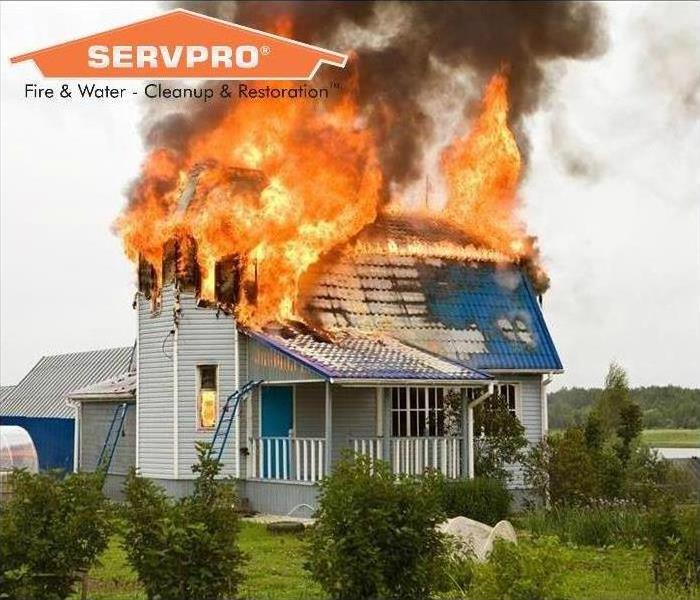 home fire
home fire
Electrical wiring
Damage to electrical wiring can cause sparks that quickly lead to damaging fires. Electrical wiring damage may include frayed cords, such as those connecting desktop computers to the wall power outlets. It may also include damage to internal wiring inside the walls, and these may be damaged by pests and other forces. Electrical fires may also start when power sockets are overloaded or when equipment gets too hot.
Flammable Materials
Flammable materials are commonly associated with industrial and warehouse environments, but even restaurants, hotels, dry cleaners and many other types of places may have flammable materials on sight.
There are numerous fire hazards that can cause serious damage to your home or business. If you or anyone you know have been affected by a fire you can call SERVPRO of South Burlington County (856) 988-6195.

 24/7 Emergency Service
24/7 Emergency Service
